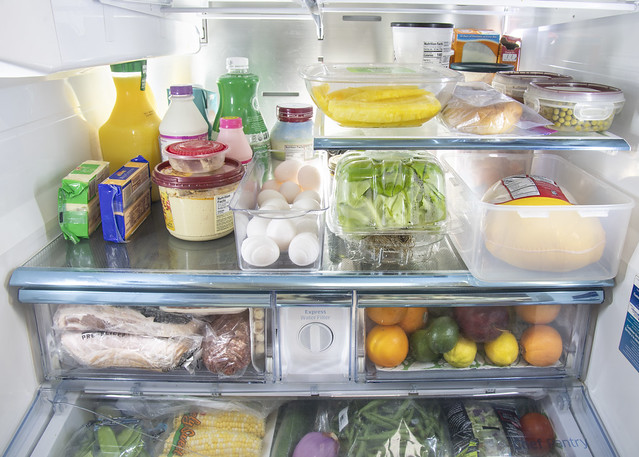How Long Will Items Last in Freezer, or Refrigerator?
go.ncsu.edu/readext?823716
en Español / em Português
El inglés es el idioma de control de esta página. En la medida en que haya algún conflicto entre la traducción al inglés y la traducción, el inglés prevalece.
Al hacer clic en el enlace de traducción se activa un servicio de traducción gratuito para convertir la página al español. Al igual que con cualquier traducción por Internet, la conversión no es sensible al contexto y puede que no traduzca el texto en su significado original. NC State Extension no garantiza la exactitud del texto traducido. Por favor, tenga en cuenta que algunas aplicaciones y/o servicios pueden no funcionar como se espera cuando se traducen.
Português
Inglês é o idioma de controle desta página. Na medida que haja algum conflito entre o texto original em Inglês e a tradução, o Inglês prevalece.
Ao clicar no link de tradução, um serviço gratuito de tradução será ativado para converter a página para o Português. Como em qualquer tradução pela internet, a conversão não é sensivel ao contexto e pode não ocorrer a tradução para o significado orginal. O serviço de Extensão da Carolina do Norte (NC State Extension) não garante a exatidão do texto traduzido. Por favor, observe que algumas funções ou serviços podem não funcionar como esperado após a tradução.
English
English is the controlling language of this page. To the extent there is any conflict between the English text and the translation, English controls.
Clicking on the translation link activates a free translation service to convert the page to Spanish. As with any Internet translation, the conversion is not context-sensitive and may not translate the text to its original meaning. NC State Extension does not guarantee the accuracy of the translated text. Please note that some applications and/or services may not function as expected when translated.
Collapse ▲Have you ever wondered how long your frozen food will last? Or, can you eat a canned good after the expiration? Maybe even which method of storage is the best? Well, if you have ever wondered about any of these things, keep reading for more information on food storage. According to the Food and Drug Administration (FDA), proper home food storage helps maintain safety and food quality by keeping flavor, color, texture, and nutrients in food.
Pantry items – Many staples and canned foods have a relatively long shelf life. However, foods stored for longer than recommended times or beyond the date on the package may change quality, color, and flavor.
 Refrigerated foods – Refrigerators should be kept at a temperature of 40°F (4°C) or below. At that temperature, bacterial growth is slowed and quality is maintained. Time limits will keep refrigerated food from spoiling or causing someone to become ill. Because product dates are not a guide for the safe use of a product, here are a few tips to follow:
Refrigerated foods – Refrigerators should be kept at a temperature of 40°F (4°C) or below. At that temperature, bacterial growth is slowed and quality is maintained. Time limits will keep refrigerated food from spoiling or causing someone to become ill. Because product dates are not a guide for the safe use of a product, here are a few tips to follow:
- Purchase the product before “sell-by” or expiration date.
- Follow handling recommendations on product.
- Keep meat and poultry in their package until just before using.
- If freezing meat and poultry in its original package longer than 2 months, cover these packages with heavy-duty foil, plastic wrap, or freezer paper. Or, place the package inside a freezer bag.
More “Dates” –
- “Best if Used By” on the package-labeling if the date is simply related to optimal quality, not safety. If the products have changed noticeably in color, consistency, or texture, consumers may want to avoid eating them.
- “Use By” date labels you see on packaged foods relate to the quality of the product, but predicting when food will no longer be of adequate quality for consumption is not an exact science.
Freezer – Freezers should be kept at 0°F (-18°C) or lower. Because freezing keeps food safe indefinitely, the following recommended freezer storage times are for quality (flavor, color, texture, etc.) only. It is also very important to purchase thermometers for both your refrigerator/freezer. You can find them in the housewares section of department, appliance, culinary, and grocery stores. Buy two! Place one in your refrigerator and one in your freezer.
Two more tips:
- Place the thermometer in the front of the refrigerator/freezer in an easy-to-read location.
- Check temperature regularly — at least once a week.
NOTE: If the freezer compartment isn’t a separate freezer compartment but a compartment inside the refrigerator, it may be impossible to obtain a 0ºF temperature. One sign of this will be soft ice cream. Plan to use food within a few weeks.
For more information on storage times for the freezer and refrigerator, visit –
- Home Food Storage – Meat, Poultry, Fish, and Eggs
- Home Food Storage – Milk and Dairy Products
- Home Food Storage – Fruit
- Home Food Storage – Vegetables
- Home Food Storage – Condiments
- Home Food Storage – Baked Goods
- Cold Food Storage Charts
Toi N. Degree, Associate Family & Consumer Education Agent with North Carolina Cooperative Extension. Toi may be reached by phone at 704-216-8970 or by email at toi_degree@ncsu.edu.




